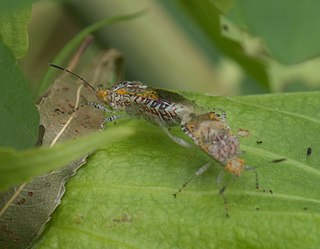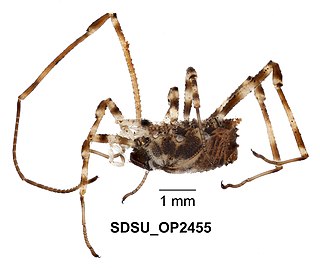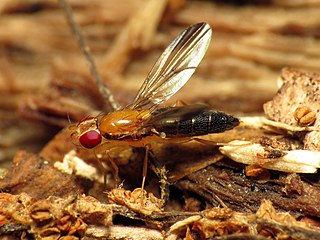The lesser Wilfred's mouse is a species of South American rodents of the family Cricetidae. It was first described by Wilfred H. Osgood under the name Thomasomys pictipes, then into the genus Wilfredomys, and now known as Juliomys pictipes. The lesser Wilfred's mouse is endemic to northeastern Argentina and southeastern Brazil. Its physical appearance ranges from dark brown to light orange coloration and the typical size is small to medium. This species is arboreal, spending most of its time trees and living in the local forests at altitudes from sea level to 2000 m. Currently, this species is listed as Least Concern by the IUCN, but, threats include livestock farming, ranching, and wood harvesting.

Apiomerus is a genus of conspicuous, brightly colored assassin bugs belonging to the family Reduviidae. The species can be found in the United States ranging into tropical America. The common name bee assassins derives from their frequent habit of sitting and waiting upon flowers and taking bees as prey. The bright colors are aposematic, likely a warning to larger predators that a painful bite can be delivered.

The Stenopodainae are a subfamily of Reduviidae. Often cryptically coloured, with prominent mandibular plates, antennal segment 1 generally strongly developed, remaining segments slender and often folded back under the first; hemelytron typically with large pentagonal or hexagonal cell in the corium. Approximately 113 genera are described, with most species found in the tropics. Many species are associated with soil or sand, and many are apterous.
Dictya pictipes is a species of marsh fly in the family Sciomyzidae.

Niesthrea is a genus of scentless plant bugs in the family Rhopalidae. There are about 13 described species in Niesthrea.
Aradus behrensi is a species of flat bug in the family Aradidae. It is found in North America.
Aradus inornatus is a species of flat bug in the family Aradidae. It is found in North America.

Aneurus simplex is a species of flat bug in the family Aradidae. It is found in North America.
Aradus acutus is a species of flat bug in the family Aradidae. It is found in North America.
Trisapromyza is a genus of flies in the family Lauxaniidae. There are at least two described species in Trisapromyza.

Ortholasma pictipes is a species of harvestman in the family Nemastomatidae. It is found in North America.

Ortholasma is a genus of harvestmen in the family Nemastomatidae with 5 described species. The genus has been revised by Shear (2010).
Aradus shermani is a species of flat bug in the family Aradidae. It is found in North America.
Aneurus borealis is a species of flat bug in the family Aradidae. It is found in North America.
Aradus intectus is a species of flat bug in the family Aradidae. It is found in North America.

Clusiodes is a genus of flies in the family Clusiidae. There are at least 70 described species in Clusiodes.
Diaditus is a genus of assassin bugs in the family Reduviidae. There are about six described species in Diaditus.
Mezira pacifica is a species of flat bug in the family Aradidae. It is found in North America.
Phylloneta pictipes is a species of cobweb spider in the family Theridiidae. It is found in the United States.
Megalopsallus is a genus of plant bugs in the family Miridae. There are at least 30 described species in Megalopsallus.






